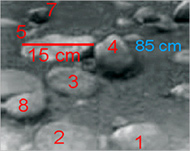Methane rain seen on Saturn’s moon
The European robot lab Huygens found liquid methane on the Saturn satellite Titan, which scientists say may have shaped the moon’s peculiar landscape and weather system.

“We’ve got a flammable world. It is quite extraordinary,” University of Honolulu researcher Toby Owen said on Friday, referring to methane’s combustibility with air on Earth.
“There is liquid on Titan. It has been raining not long ago, there is liquid methane,” Jean-Pierre Lebreton, director of the Huygens mission at the European Space Agency (ESA), said.
“There are truly remarkable processes at work on Titan’s surface,” he added.
US researcher Marty Tomasko of the University of Arizona said the data sent back by Huygens showed “many familiar Earth-like processes: abrasion, erosion, precipitation”.
“On the place where we landed, it had been raining not long ago, maybe two days ago,” Tomasko said at a presentation to the press at ESA headquarters in Paris.
Toxic liquid
The rain – not water but liquid methane, which is toxic to humans – causes soil to run down from the hills and forms the rivulets and gullies that were visible in the raw images of Titan, shown to the world last week.
 |
|
Titan has been sending images |
Huygens, a 319kg craft fitted with cameras, atmospheric sensors and gas analysers, landed on Titan on 14 January, sending back data to a US mother-ship, Cassini.
Titan, the largest satellite of Saturn, was chosen as it is the only moon in the solar system that has a substantial atmosphere.
Its thick mix of nitrogen and methane is suspected to be undergoing chemical reactions similar to those that unfolded on Earth billions of years ago. That process eventually provided the conditions for life on our planet.
More data analysis
Scientists will need months to pore over the data to see whether the theory holds true.
The mission, the farthest landing from Earth ever attempted, was “exploration as well as science”, said ESA’s director of science, David Southwood, who described it as “the most wonderful event in my career”.
 |
|
Scientists have only received half |
At best, scientists had hoped Huygens would keep transmitting for three brief minutes after hitting Titan’s surface. Instead, they said instruments probably continued to function for at least three hours after the 15km per hour touchdown.
The only flaw in the mission was the loss of one of two data channels that were used to relay the findings home via Cassini.
Fewer images
Instead of 700 images being sent back, only about 350 were received, showing a fog-strewn orange-tinged planet surface.
On Thursday, a study published in the British journal Nature reported that Cassini, carrying Huygens, ran into major dust storms as it raced towards its rendezvous with Saturn last year.
The microscopic grains smashed into Cassini with an impact speed of more than 100km per second.
The grains are believed to compose minute crystals of water ice which carry a positive electrical charge.
They achieved their enormous velocity because they were flung into space by the mighty whirling magnetic field generated by Saturn, the authors suspect.